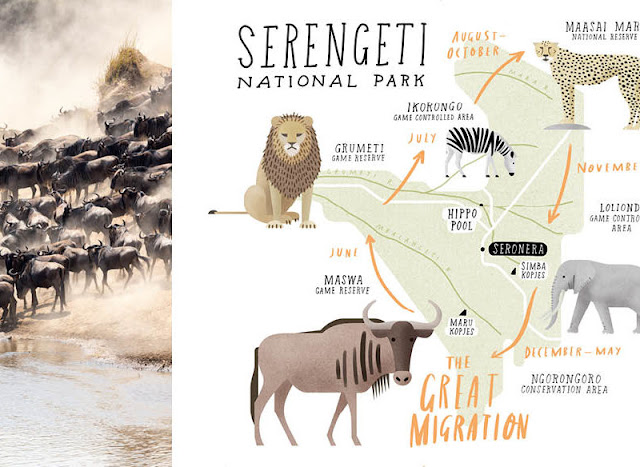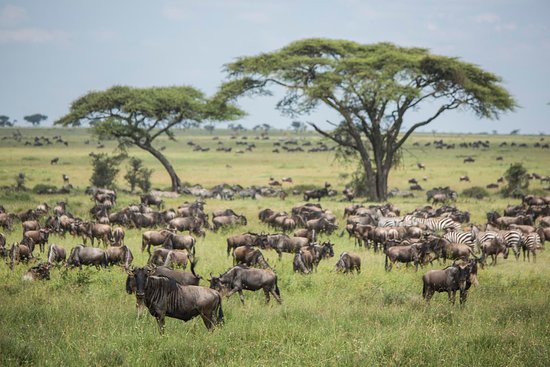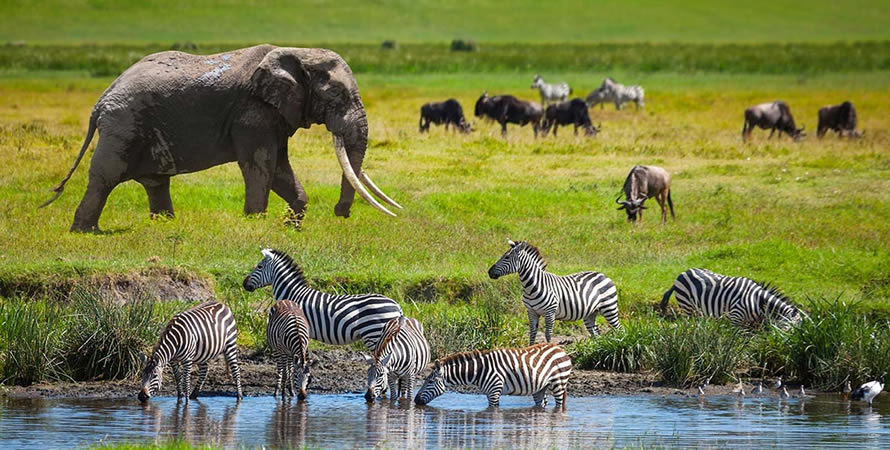Serengeti National Park Tanzania The greatest wildlife destination on earth

Hello Tanzania, East Africa, Serengeti National Park is one of the famous and recognizable national park. The annual Great Migration of wildebeest and other animals makes it one of the most famous wildlife conservation areas in the world. It is also known for its amazing diversity of species. Tanzania’s Serengeti National Park, or simply “Serengeti,” is well-known for its large number of species and the annual big wildebeest migration.
The Serengeti covers an area of 14,763 square miles (5,700 square kilometres) extending northward to Kenya and westward to Lake Victoria. The Serengeti boasts the greatest concentration of large mammals on the planet and is well-known for having the most lions—2,500—of any place. The park also features over 518 bird species that have been identified, some of which are migrating Eurasians that are there from October to April throughout the European winter.
Best visit time in Serengeti National Park Tanzania
The greatest time to visit is from December to July, and the best time to observe predators is from June to October, when the wildebeest migrate from Serengeti National Park to Maasai Mara National
Reserve Recommended number of days:
A three or four-day safari is advised due to the abundance of wildlife in the reserve. The longer you remain, the greater your chances are of getting the best images if photography is your hobby.

Wildebeest Migration in the Serengeti:
The Great Migration is one of the most amazing wildlife spectacles that takes place there every year. Wildebeest and other herbivores are moving in a circular pattern in search of new grazing areas and water sources. Throughout the year, M migration essentially follows the following pattern.
- From December through April, the southern Serengeti Plains are home to herds that give birth to their young during the mating season. Predators like lions and hyenas are drawn to this time period, creating dramatic scenes of survival and hunting.
- From May to July, herds start to migrate north via the Serengeti’s western corridor and center, crossing the Grumeti River and potentially encountering crocodile-infested waters.
- August to October: The wildebeest continue to move north and often cross the Mara River into the Maasai Mara Reserve in Kenya, where they stay until the short rains begin.

The main features of the Serengeti National Park Tanzania are as follows:
Accommodations:
The Serengeti Ecosystem offers a variety of locations to stay. Even though the Serengeti is only 335 kilometres (208 miles) from Arusha, the roads make the trip there still take a very long time. It is advised to make a halt along the road if you are travelling by car to the Serengeti National Park. We would like to emphasise that it is advisable to arrive at the rim the afternoon before and spend the entire following day in the Crater if you are interested in visiting the Ngorongoro Crater on the way. It is better to arrive at the rim the previous afternoon and spend the entire following day in the Crater.
Read more…
FAQS Serengeti National Park Tanzania
1. What makes Serengeti National Park famous?
Ans = Serengeti National Park is renowned for the annual Great Migration, where millions of wildebeest, zebras, and other wildlife traverse the plains in search of fresh grazing grounds.
2. When is the best time to witness the Great Migration?
Ans = The best time to witness the Great Migration in Serengeti National Park is generally from late June to early October when the herds cross the Mara River, facing various challenges and providing a spectacular wildlife spectacle.
3. What wildlife can be spotted in Serengeti National Park?
Ans = Serengeti boasts a diverse array of wildlife, including the “Big Five” (lion, leopard, elephant, buffalo, and rhinoceros), cheetahs, giraffes, hippos, crocodiles, and numerous bird species.
4. How large is Serengeti National Park?
Ans = Serengeti National Park covers an expansive area of approximately 14,763 square kilometers, making it one of the largest and most iconic wildlife reserves in Africa.
5. Are hot air balloon safaris available in Serengeti?
Ans = Yes, hot air balloon safaris are a popular and unique way to experience the vast landscapes and wildlife of Serengeti National Park, offering breathtaking views and a chance to witness the sunrise.
6. What is the Serengeti ecosystem?
Ans =The Serengeti ecosystem extends beyond the national park boundaries, encompassing the Ngorongoro Conservation Area and the Maswa Game Reserve. It is a complex and interconnected system supporting an abundance of flora and fauna.
7. Are self-drives allowed in Serengeti National Park?
Ans =No, self-drives are not permitted in Serengeti National Park. Visitors must explore the park with a certified guide or join organized safari tours to ensure safety and adherence to park regulations.
8. What is the significance of the Serengeti in terms of conservation?
Ans = Serengeti National Park plays a crucial role in wildlife conservation, providing a protected habitat for numerous species. It is also a UNESCO World Heritage Site, recognizing its ecological importance.
9. Can you camp in Serengeti National Park Tanzania ?
Ans = Camping is allowed in designated campsites within the park, offering a unique opportunity to experience the sounds of the African wilderness at night. Visitors should follow camping regulations to minimize environmental impact.
10. How do I reach Serengeti National Park Tanzania ?
Ans = Most visitors fly into Kilimanjaro International Airport or Julius Nyerere International Airport in Tanzania and then take a connecting flight or drive to Serengeti. Local airstrips within the park facilitate easy access.
Plan your visit to Serengeti National Park and witness the magic of the African wilderness!

